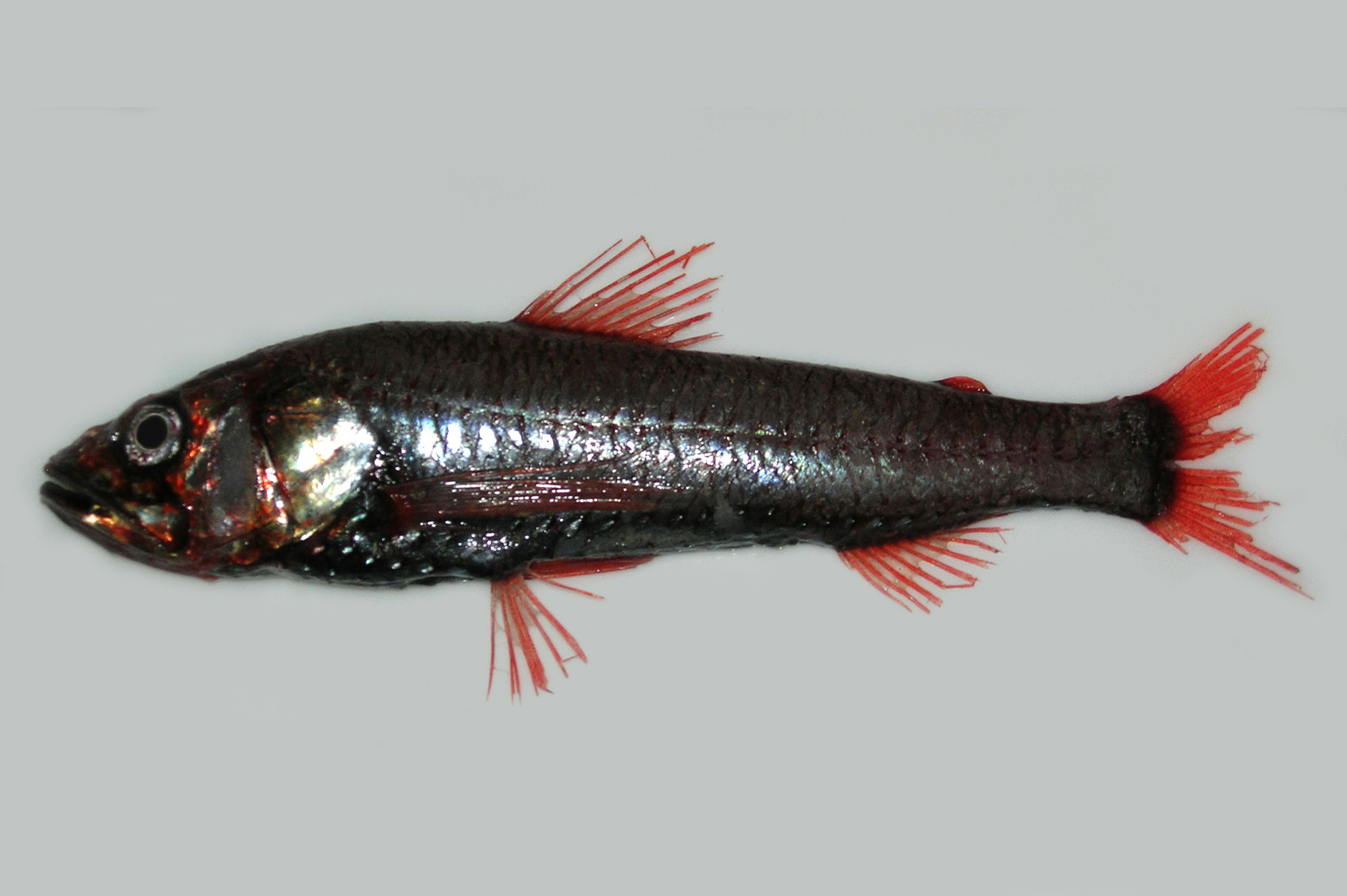- Classification
- ACTINOPTERYGII
- MYCTOPHIFORMES
- NEOSCOPELIDAE
- Neoscopelus
- macrolepidotus
Largescaled Neoscopelid, Neoscopelus macrolepidotus Johnson 1863
Other Names: Largescale Neoscopelid, Largescale New Lanternfish, Large-scaled Lanternfish, Large-scaled Lantern-fish

A Largescale Neoscopelid, Neoscopelus macrolepidotus - taken in a beam trawl south of Scott Reef, Western Australia, 407-414 m. Source: Dianne J. Bray / Museum Victoria. License: CC BY Attribution
Summary:
A dark silvery greyish-red neoscopelid with a darker belly, a silvery head, pinkish-red fins, and rows of light organs (photophores) along the ventral portion of the body and inside the mouth along the sides of the tongue.
Cite this page as:
Dianne J. Bray, Neoscopelus macrolepidotus in Fishes of Australia, accessed 29 Mar 2025, https://fishesofaustralia.net.au/home/species/4023
Largescaled Neoscopelid, Neoscopelus macrolepidotus Johnson 1863
More Info
|
Distribution |
East of the Murray Isles, Queensland, southwards around the southern part of Australia to off Ashmore Reef, Timor Sea; also in the Lord Howe Island region and in the Australian territory of Norfolk Island. Elsewhere the species occurs in the Atlantic, Indian and Pacific Oceans. Benthopelagic on the continental slope. |
|
Features |
Dorsal fin 12-13; Anal fin 12-13; CAudal fin 17-19; Pectoral fin 18-19; Pelvic fin 9; Vertebrae 31-32; Gill rakers 2 + 8-10. Body shallow (22-26% SL), elongate, compressed. Head of moderate size (33-36% SL); eyes moderately large (20-23% HL); mouth large, upper jaw expanded posteriorly, extending to or behind level of hind margin of eye; outer jaw teeth small and villiform, inner jaw teeth enlarged and depressible; patches or bands of small teeth on vomer, palatines, mesopterygoids and ectopterygoids in roof of mouth; row of light organs on either side of tongue. Scales large, cycloid, deciduous, rarely seen on trawled specimens. One midventral row and two lateral rows of light organs; uppermost lateral row with 12--15 photophores ending just before anal-fin origin. Single, high, dorsal fin supported by rays, with base terminating near centre of body; small adipose fin behind dorsal; anal fin under adipose fin; caudal fin forked. Pectoral fins long, reaching anus. Pelvic fins shorter than and inserted behind pectorals, not reaching anus. |
|
Biology |
Members of the genus Neoscopelus have intrinsic bioluminescence, meaning that they produce the light themselves, rather than having bioluminescent bacteria within the photophores. |
|
Similar Species |
Differs from other species in the genus Neoscopelus in having the least number of gill rakers on the first gill arch, and the most number of pectoral-fin rays. |
|
Species Citation |
Neoscopelus macrolepidotus Johnson 1863, Proc. Zool. Soc. London 1863: .44, pl. 7. Type locality: Madeira. |
|
Author |
Dianne J. Bray |
|
Resources |
Largescaled Neoscopelid, Neoscopelus macrolepidotus Johnson 1863
References
Johnson, J.Y. 1863. Descriptions of five new species of fishes obtained at Madeira. Proceedings of the Zoological Society of London 1863: 36-47 pl. 7
Nafpaktitis, B.G. 1977. Family Neoscopelidae. In, Gibbs, R.H. (ed.) Fishes of the western North Atlantic. Memoir. Sears Foundation of Marine Research 1(7): 1-12 figs 1-5
Okiyama, M. 1993. An atlas of the early stage fishes in Japan. Koeltz Scientific Books, Germany. 1154 pp.
Paxton, J.R. 1994. Families Neoscopelidae, Myctophidae. pp. 275-279 figs 246-249 in Gomon, M.F., Glover, C.J.M. & Kuiter, R.H. (eds). The Fishes of Australia's South Coast. Adelaide : State Printer 992 pp. 810 figs.
Paxton, J.R. & Bray, D.J. 2008. Family Neoscopelidae. pp. 269-270 in Gomon, M.F., Bray, D.J. & Kuiter, R.H. (eds). Fishes of Australia's Southern Coast.Sydney : Reed New Holland 928 pp.
Paxton, J.R. & P.A. Hulley. 1999. Families Neoscopelidae and Myctophidae, pp. 1955-1965, In Carpenter, K.E. & V.H. Niem. Species identification guide for fisheries purposes. The living marine resources of the western central Pacific. Batoid fishes, chimeras and bony fishes part 1 (Elopidae to Linophrynidae). FAO, Rome.
Whitley, G.P. 1931. New names for Australian fishes. The Australian Zoologist 6(4): 310-334 1 fig. pls 25-27 (p. 90, pl. 17, as Neoscopelus bruuni)



